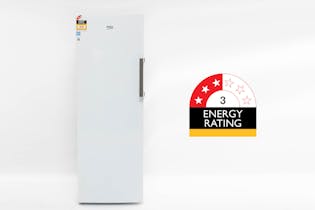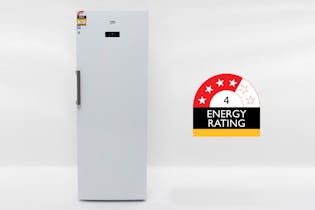Freezers
Find the best freezer for your home with our buying guide and test results for 11 current and 16 discontinued models.
Our test assesses how well freezers manage temperature on a daily basis as well as how fast they are to warm up when power is cut and how quickly they cool back down.
Choosing which models to test
As much as we’d love to, we can’t test every freezer on the market. Testing is expensive and time consuming, and we have a limited budget.
Instead, we regularly survey the market, and discuss with manufacturers which models will be deleted, which are staying current and what new models will be released in the near future. We then choose a representative selection of freezers for testing, including both cheaper and more expensive ones, chest and upright models, as well as any models with new or interesting features.
If you don’t see the model you’re considering purchasing in our test results, then try and identify a similar model by the same manufacturer, and pay attention to our brand reliability and satisfaction results – if you choose a brand that scores highly, you’ll likely end up with a good model that will also last you a long time.
Lifetime score
Our overall score combines test performance (how well the appliance works) with predicted reliability (how likely models from the brand are to remain free of faults) and brand satisfaction (how likely owners of the brand are to be very satisfied).
 We’ll only recommend appliances you’ll love to own, that work well and keep working well for a long time.
We’ll only recommend appliances you’ll love to own, that work well and keep working well for a long time.
Temperature control
We base our temperature performance assessment on:
how well a freezer deals with a warm load being added
how a freezer copes with changes in ambient temperature
freezer temperatures throughout its daily operation and whether they’re uniform
whether the default temperature settings are appropriate for safe temperature control.

Warm-up
This is how long it takes the freezer to warm up if power is cut. The freezer is switched off in a room with an ambient temperature of 32°C. We time how long it takes for the freezer to warm from -15°C to -5°C.
Cool-down
We measure how long it takes to cool the air in an empty freezer from when it’s switched on until it reaches -13°C in a warm (42°C) temperature-controlled room. Cool-down times will be longer and more variable with food in the freezer.

Predicted reliability
It’s reasonable to expect a new appliance to remain fault-free for at least the first 5 years. Our predicted reliability won’t tell you whether the freezer in your garage will start to leak tomorrow, but it does show which brands make models that are less likely to fail.
Brand satisfaction
Satisfaction is important – no appliance should be a source of buyer regret. Appliances with very satisfied owners are more likely to get cleaned regularly and be maintained well. Their owners are also more likely to get any faults repaired, rather than looking for a quick replacement.
Food safety
We focus on functionality that can affect the safety of your food in the freezer, such as the appliance’s ability to manage temperature fluctuations, its ability to keep temperatures stable throughout and how well it deals with seasonal temperature changes such as heat in summer and cold in winter.
Survey data
In our annual reliability and satisfaction survey, consumers tell us about faults that have left an appliance they own unusable or mean they’ve had to change how they use it. We also ask them how satisfied they are with the appliance. We use this data to produce our predicted reliability and owner satisfaction scores.
We use a statistical test to rate the relative performance of each brand. Compared to data we have for all products (of the same type) in the survey, we rate each brand with highest, high, average, low or lowest reliability and satisfaction. You can compare the ratings for different brands of the same product type (for example, the reliability rating for Westinghouse and Haier freezers), but you can’t compare the results for different product types (for example, satisfaction with a Fisher & Paykel freezer and an LG dishwasher).
We analyse brands that get at least 30 responses in our survey. That means there are some brands we can’t analyse because we don’t have enough data. For those brands, we assume they have average predicted reliability and owner satisfaction.
Our data is based on responses for 3,169 fridges, fridge freezers, and freezers in our 2023 survey.
Test performance
Our overall score is made up of the following:
Temperature performance
We based our temperature performance assessment on:
- how well a freezer deals with a warm load being added
- how a freezer copes with changes in ambient temperature
- freezer temperatures throughout daily operation
- if the default temperature settings are appropriate for safe temperature control.
Warm-up
This is how long it takes the freezer to warm up if power is cut. The freezer is switched off in a room with an ambient temperature of 32°C. We time how long it takes for the freezer to warm from -15°C to -5°C.
Cool-down
We measure how long it takes to cool the air in an empty freezer from when it’s switched on until it reaches -13°C in a warm (42°C) temperature-controlled room. Cool-down times will be longer and more variable with food in the freezer.
Predicted reliability
It’s reasonable to expect a new appliance to remain fault-free for at least the first five years. Our predicted reliability won’t tell you whether the freezer will cause freezer burn on your steak, but it does show which brands make models that are less likely to fail.
Owner satisfaction
Satisfaction is important – no appliance should be a source of buyer regret. Appliances with very satisfied owners are more likely to get cleaned regularly and maintained well. Their owners are also more likely to seek repair for faults than look for a quick replacement.
Food safety
This assessment focuses on functionality that can affect the safety of your food in the freezer, such as the appliance’s ability to manage temperature fluctuations, its ability to keep temperatures stable throughout the freezer and how well it deals with seasonal temperature changes such as heat in summer and cold in winter.
Survey data 101
In our annual reliability and satisfaction survey, consumers tell us about faults that have left an appliance they own unusable or mean they’ve had to change how they use it. We also ask them how satisfied they are with the appliance. We use this data to produce our predicted reliability and owner satisfaction scores.
We use a statistical test to rate the relative performance of each brand. Compared to data we have for all products (of the same type) in the survey, we rate each brand with highest, high, average, low or lowest reliability and satisfaction. You can compare the rating of different brands for the same product type (for example, the reliability rating for Westinghouse and Haier freezers), but you can’t compare the results for different product types (for example, satisfaction of Fisher & Paykel freezer and Miele dishwasher).
We analyse brands that get at least 30 responses in our survey. That means there are some brands we can’t analyse because we don’t have enough data. For those brands, we assume they have average predicted reliability and owner satisfaction.
Our data is based on responses for 3169 fridges, fridge-freezers and freezers in our 2023 survey.
We've tested 27 freezers.
Find the right one for you.
Beko

Beko

Haier

